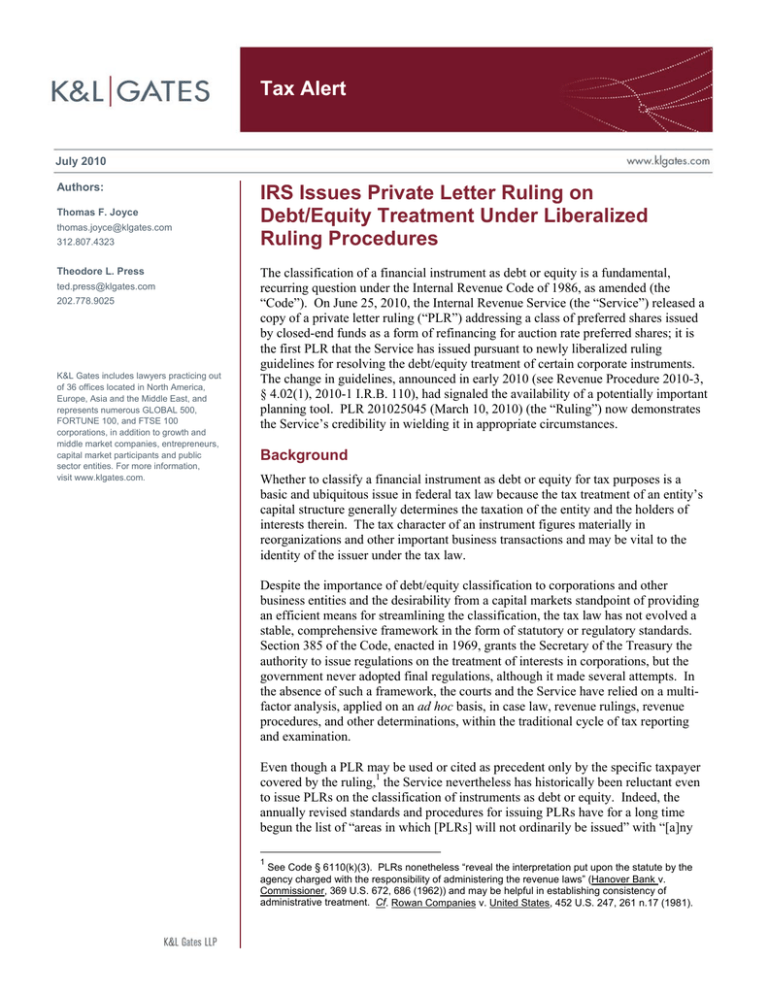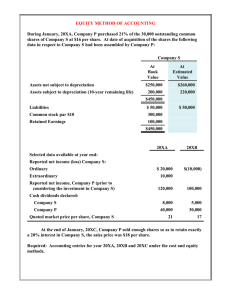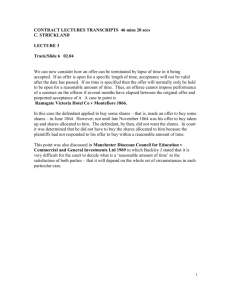
Tax Alert
July 2010
Authors:
Thomas F. Joyce
thomas.joyce@klgates.com
312.807.4323
Theodore L. Press
ted.press@klgates.com
202.778.9025
K&L Gates includes lawyers practicing out
of 36 offices located in North America,
Europe, Asia and the Middle East, and
represents numerous GLOBAL 500,
FORTUNE 100, and FTSE 100
corporations, in addition to growth and
middle market companies, entrepreneurs,
capital market participants and public
sector entities. For more information,
visit www.klgates.com.
IRS Issues Private Letter Ruling on
Debt/Equity Treatment Under Liberalized
Ruling Procedures
The classification of a financial instrument as debt or equity is a fundamental,
recurring question under the Internal Revenue Code of 1986, as amended (the
“Code”). On June 25, 2010, the Internal Revenue Service (the “Service”) released a
copy of a private letter ruling (“PLR”) addressing a class of preferred shares issued
by closed-end funds as a form of refinancing for auction rate preferred shares; it is
the first PLR that the Service has issued pursuant to newly liberalized ruling
guidelines for resolving the debt/equity treatment of certain corporate instruments.
The change in guidelines, announced in early 2010 (see Revenue Procedure 2010-3,
§ 4.02(1), 2010-1 I.R.B. 110), had signaled the availability of a potentially important
planning tool. PLR 201025045 (March 10, 2010) (the “Ruling”) now demonstrates
the Service’s credibility in wielding it in appropriate circumstances.
Background
Whether to classify a financial instrument as debt or equity for tax purposes is a
basic and ubiquitous issue in federal tax law because the tax treatment of an entity’s
capital structure generally determines the taxation of the entity and the holders of
interests therein. The tax character of an instrument figures materially in
reorganizations and other important business transactions and may be vital to the
identity of the issuer under the tax law.
Despite the importance of debt/equity classification to corporations and other
business entities and the desirability from a capital markets standpoint of providing
an efficient means for streamlining the classification, the tax law has not evolved a
stable, comprehensive framework in the form of statutory or regulatory standards.
Section 385 of the Code, enacted in 1969, grants the Secretary of the Treasury the
authority to issue regulations on the treatment of interests in corporations, but the
government never adopted final regulations, although it made several attempts. In
the absence of such a framework, the courts and the Service have relied on a multifactor analysis, applied on an ad hoc basis, in case law, revenue rulings, revenue
procedures, and other determinations, within the traditional cycle of tax reporting
and examination.
Even though a PLR may be used or cited as precedent only by the specific taxpayer
covered by the ruling,1 the Service nevertheless has historically been reluctant even
to issue PLRs on the classification of instruments as debt or equity. Indeed, the
annually revised standards and procedures for issuing PLRs have for a long time
begun the list of “areas in which [PLRs] will not ordinarily be issued” with “[a]ny
1
See Code § 6110(k)(3). PLRs nonetheless “reveal the interpretation put upon the statute by the
agency charged with the responsibility of administering the revenue laws” (Hanover Bank v.
Commissioner, 369 U.S. 672, 686 (1962)) and may be helpful in establishing consistency of
administrative treatment. Cf. Rowan Companies v. United States, 452 U.S. 247, 261 n.17 (1981).
Tax Alert
matter in which the determination requested is
primarily one of fact, e.g., . . . whether an interest in
a corporation is to be treated as stock or
indebtedness.” (Emphasis added.) Although the
“will not ordinarily rule” standard seemed to allow
for the possibility of a PLR in “unique and
compelling” circumstances, the Service’s stance was
generally interpreted as a bar to obtaining a binding
advance determination on the classification of a
particular instrument.
Revenue Procedure 2010-3 and the
Ruling
In early 2010, the Service announced a significant
change in its ruling procedures by adding the
following qualifying language to the traditional
proscription against issuing PLRs on debt/equity
questions:
Although it is generally inappropriate for the
Service to issue a letter ruling on whether an
interest in a corporation is stock or
indebtedness, there may be instances in which
the Service may issue a letter ruling. For
example, the Service may issue a letter ruling
with respect to an instrument issued by a
domestic corporation if (1) the taxpayer believes
that the facts strongly support the classification
of the instrument as stock and (2) the taxpayer
can demonstrate that there are unique and
compelling reasons to justify the issuance of a
letter ruling.
The Service has now fulfilled the promise of
administrative flexibility in Revenue Procedure
2010-3 by issuing the Ruling to a taxpayer seeking
confirmation that a proposed class of mandatorily
redeemable preferred stock should be treated as
equity for federal tax purposes.
Analysis
The instrument in the Ruling was preferred shares
(“New Preferred Shares”) to be issued by a closedend management investment company (the “Fund”)
operating as a regulated investment company under
subchapter M of the Code (a “RIC”). The Fund
already had outstanding (i) a class of “auction rate
preferred shares” (“ARPS”),2 (ii) a series of
mandatorily redeemable preferred shares issued for
the purpose of raising capital to redeem a portion of
the Fund’s outstanding ARPS, and (iii) common
shares. New Preferred Shares would be issuable in
two additional series and would be subject to
mandatory redemption at the end of a certain
number of years and would further facilitate the
refinancing of ARPS. Although the Ruling did not
identify the specific terms of years of the two series
of New Preferred Shares, one may infer that the
redemption periods are relatively short, because
authority in other contexts seems to have endorsed
equity treatment for mandatorily redeemable
preferred stock having a term of five years. (See,
e.g., Rev. Rul. 78-142, 1978-1 C.B. 111.)
In the Ruling the status of New Preferred Shares as
equity for tax purposes was not merely important in
clarifying the nature of the investment return to the
holders of a public security and the tax accounting
for the Fund’s payments on the shares. It was
crucial to the Fund’s operation as a RIC, because
dividends with respect to equity issued by a RIC -as opposed to interest on a RIC’s debt -- are eligible
to pass through to its shareholders the character of
the income the RIC earns (in this case, exempt
interest on municipal bonds). If the New Preferred
Shares failed to qualify as equity for federal tax
purposes, the dividend-accounting mechanism that
ensures subchapter M compliance would likely fail
to preserve the Fund’s status as a RIC. It is not an
exaggeration to describe the loss of the pass-through
treatment for the Fund’s exempt interest as
catastrophic.
Under the multi-factor tests customarily used by the
Service to analyze the debt/equity treatment of
instruments, preferred stock generally has been
treated as equity. However, dicta in a few older
cases, combined with facts suggestive of a debt
character, seemed to support holdings that certain
preferred stock with mandatory redemption terms
should be treated as debt for tax purposes. As a
2
ARPS, although perpetual, were designed to be liquid
through an auction or remarketing process that reset their
dividend rates periodically at a market-clearing price that
facilitated resale. However, the national market for ARPS had
“frozen” in February 2008, when ARPS remarketing
mechanisms experienced severe liquidity difficulties, and it
has generally remained impaired since then.
July 2010
2
Tax Alert
theoretical matter, a sufficiently short mandatory
redemption period, considered as one of the
traditional debt/equity factors, could be viewed as
imparting a debt-like flavor to an instrument because
of the contractual assurance that holders would
receive a return of their investment on a date certain,
especially when a mandatory redemption term is
coupled with a regular preferred stock dividend rate.
Despite the near-century of interpretations by the
courts and the Service in the debt/equity area, the
status of mandatorily redeemable preferred stock
had never received a clear resolution, at least at
terms of less than five years. For a RIC like the
Fund, even a possibility that the New Preferred
Shares might be treated as debt, rather than equity,
would thwart the marketability of the instrument and
thus further frustrate efforts to find economically
viable alternative financing and to restore liquidity
to the ARPS market.
In the Ruling, the Service held that interests in the
form of New Preferred Shares having either of the
two mandatory redemption terms would qualify as
equity for federal tax purposes. The Ruling noted
that the Fund had made the following
representations, among others:
The shares of each series would rank on a
parity with shares of each other series of
New Preferred Shares and with any other
preferred shares series as to the payment of
dividends and the distribution of assets
upon dissolution, liquidation or winding up
of the affairs of the Fund.
Each series of New Preferred Shares would
have preference in distributions over shares
of common stock.
No holder of New Preferred Shares would
have, solely by reason of being such a
holder, any preemptive or other right to
acquire, purchase or subscribe for any New
Preferred Shares or common shares or other
securities the Fund might thereafter issue or
sell.
The holders of New Preferred Shares of any
series would be entitled to receive, when, as
and if declared by, or under the authority
granted by, the Board of Trustees, out of
funds legally available therefor and in
preference to distributions on common
shares of the Fund, cumulative cash
distributions on each share of such series.
In the event of any dissolution, liquidation
or winding up of the affairs of the Fund,
whether voluntary or involuntary, the
holders of New Preferred Shares would be
entitled to receive out of the Fund’s assets
available for distribution to shareholders,
after satisfying claims of creditors but
before any distribution or payment made in
respect of the common shares, a liquidation
distribution.
The Fund would redeem all shares of a
series of New Preferred Shares on the
redemption date for such series, at a price
per share described in the appropriate
documents, but only out of funds legally
available therefor under state corporate law.
Holders of New Preferred Shares would
possess voting rights that are at least as
extensive as the voting rights possessed by
holders of the Fund’s common shares.
In holding that the New Preferred Shares were
equity for tax purposes, the Service did not change
or depart from the multi-factor test or otherwise act
inconsistently with respect to the extensive body of
case law and administrative law dealing with
debt/equity questions. Rather, it illustrated how the
mandatory redemption terms being proposed for the
Fund’s New Preferred Shares should be applied
within the traditional multi-factor approach.
Conclusion
While the Ruling should not be interpreted as
altering any substantive standards of debt/equity
classification, it resolved an important gap in
existing law in the circumstances presented by the
Fund. By providing this clarification in advance, in
the form of a PLR, the Service helped eliminate a
market imperfection that might have taken years to
resolve under the traditional laissez-faire policy that
relegated debt/equity questions to the tax reporting
and examination cycle. Looking beyond the effects
on the Fund and its securities holders, it is not
difficult to predict that other ARPS issuers may
imitate this capital structure as part of their efforts
to thaw their frozen ARPS. More broadly still,
other corporate taxpayers in need of clarification of
the status of other instruments as equity for tax
purposes should consider availing themselves of the
July 2010
3
Tax Alert
new tool provided by Revenue Procedure 2010-3
and exemplified by the Ruling.
* * *
Circular 230 Notice
To ensure compliance with requirements imposed by the IRS, we inform you that any U.S. federal tax advice contained in this
communication (including any attachments) is not intended or written to be used, and cannot be used, for the purpose of (i)
avoiding penalties under the Internal Revenue Code of 1986, as amended or (ii) promoting, marketing or recommending to
another party any transaction or matter addressed within.
Anchorage Austin Beijing Berlin Boston Charlotte Chicago Dallas Dubai Fort Worth Frankfurt Harrisburg Hong Kong London
Los Angeles Miami Moscow Newark New York Orange County Palo Alto Paris Pittsburgh Portland Raleigh Research Triangle Park
San Diego San Francisco Seattle Shanghai Singapore Spokane/Coeur d’Alene Taipei Tokyo Warsaw
Washington, D.C.
K&L Gates includes lawyers practicing out of 36 offices located in North America, Europe, Asia and the Middle East, and represents numerous
GLOBAL 500, FORTUNE 100, and FTSE 100 corporations, in addition to growth and middle market companies, entrepreneurs, capital market
participants and public sector entities. For more information, visit www.klgates.com.
K&L Gates is comprised of multiple affiliated entities: a limited liability partnership with the full name K&L Gates LLP qualified in Delaware and
maintaining offices throughout the United States, in Berlin and Frankfurt, Germany, in Beijing (K&L Gates LLP Beijing Representative Office), in
Dubai, U.A.E., in Shanghai (K&L Gates LLP Shanghai Representative Office), in Tokyo, and in Singapore; a limited liability partnership (also named
K&L Gates LLP) incorporated in England and maintaining offices in London and Paris; a Taiwan general partnership (K&L Gates) maintaining an
office in Taipei; a Hong Kong general partnership (K&L Gates, Solicitors) maintaining an office in Hong Kong; a Polish limited partnership (K&L
Gates Jamka sp. k.) maintaining an office in Warsaw; and a Delaware limited liability company (K&L Gates Holdings, LLC) maintaining an office in
Moscow. K&L Gates maintains appropriate registrations in the jurisdictions in which its offices are located. A list of the partners or members in each
entity is available for inspection at any K&L Gates office.
This publication is for informational purposes and does not contain or convey legal advice. The information herein should not be used or relied upon
in regard to any particular facts or circumstances without first consulting a lawyer.
©2010 K&L Gates LLP. All Rights Reserved.
July 2010
4




